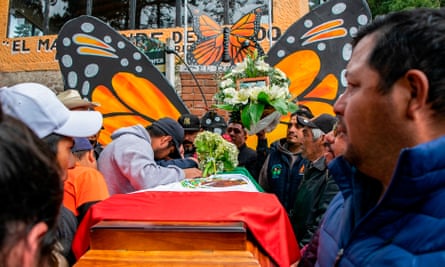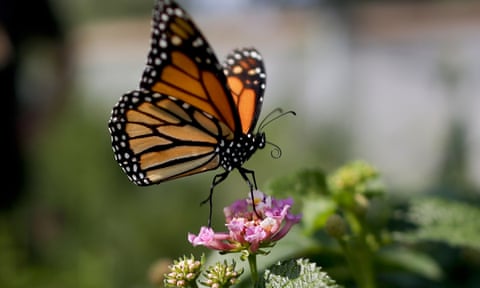The annual migration of monarch butterflies from the US and Canada is one of the most resplendent sights in the natural world – a rippling orange-and-black wave containing millions of butterflies fluttering instinctively southward to escape the winter cold.
The spectacle when they reach their destination in central Mexico is perhaps even more astonishing. Patches of alpine forest turn from green to orange as the monarchs roost in the fir trees, the sheer weight of butterflies causing branches to sag to the point of snapping. Tens of thousands of the insects bounce haphazardly overhead, searching replenishment from nearby plants.
Q&AWhat is so special about monarch butterflies?
Show

Monarch butterflies weigh just half a gram but are able to undertake an epic migration of up to 3,000 miles – a unique phenomenon in the insect world.
A voracious eater, the monarch caterpillar can consume an entire milkweed leaf in less than five minutes. The species is entirely dependent upon milkweed for its propagation.
The monarch’s bodies retain the toxins present in the milkweed, making them an unappetizing snack for birds.
Scientists believe that monarchs navigate using the angle of the sun, setting off on their southward journey when the sun hits a certain point in the sky, no matter the stage of their journey.
The species roosts in huge numbers in fir trees situated more than 3,000 metres above sea level in the forested volcanoes of central Mexico, having travelled from as far north as southern Canada.
Monarchs are an important tourist drawcard for communities in and around the protected reserve in Mexico. The species has long had a cultural resonance, too – pottery unearthed from the era before Spanish conquest features depictions of the butterflies.
To witness this sight is as if to enter a waking dream. “People have a spiritual and emotional connection to monarchs,” said Sonia Altizer, a monarch butterfly researcher at the University of Georgia. “Many people tell me that seeing them was a highlight of their life.”
The recent deaths of two butterfly conservationists in the region has, however, drawn attention to a troubling tangle of disputes, resentments and occasional bouts of harrowing violence that has lingered over the Monarch Butterfly Biosphere Reserve, a sprawling world heritage site situated 60 miles north-west of Mexico City.
En el Santuario El Rosario Ocampo Michoacan miles de Monarcas buscando agua .....El más grande del mundo pic.twitter.com/hXgAYk1Ztb
— Homero gomez g. (@Homerogomez_g) January 13, 2020
Mustachioed and gregarious, Homero Gómez González tirelessly promoted the El Rosario sanctuary, a section of the butterfly reserve that receives the bulk of tourists who come from around the world to see the monarchs. He featured in mesmerizing social media videos – posing with butterflies fluttering around him – and called the creatures “a marvel of nature”.
Gómez, who was 50, disappeared on 13 January after attending a patron saint festival in the municipality of Ocampo; his body was found two weeks later at the bottom of a watering hole. His death has yet to be ruled a murder, although police say he suffered a blunt trauma to the head.
The incident raised fears that gangs, possibly tied to the illegal logging of the butterfly reserve, had targeted Gómez for his advocacy of ecotourism over the felling of trees in this rugged swath of Mexico where communities, often beset by poverty, have traditionally relied upon the harvesting of timber, potatoes and wheat.

Those concerns were further heightened this week after the death of a part-time tour guide from another nearby butterfly sanctuary, called Raúl Hernández Romero. His body was found 1 February with injuries possibly inflicted by a sharp object.
“The panorama for the community, the forest and the monarch butterflies is now very complicated and uncertain,” Amado Gómez González, one of Gómez’s nine siblings, told the Guardian.
“There are now these two crimes and it has spread fear. You find yourself thinking ‘What if this is a group that is coming to try and take the sanctuary away from us?”
Investigations into the two deaths are ongoing. But some conservationists fret they are a byproduct of the violence that has long troubled the state of Michoacán, which stretches from the mountains of central Mexico to the west coast.
As they have done across the country, organized crime groups linked to the drug trade have diversified into many other activities, including kidnapping, avocado cultivation, land theft – and the lucrative market in pine, fir and cedar wood.
Logging is supposedly under tight controls, but high prices mean lumber mafias often stray into protected areas – and are prepared to use violence. “In Michoacán, a tree is worth more than a human life,” said one former state official.
“Homero Gómez was in conflict with these loggers,” said Homero Aridjis, an environmentalist and poet, who is a longtime defender of the monarch butterfly sanctuaries. “They’ve always been a very dangerous group because there are always politicians, businessmen involved in deforestation.”

Aridjis said his own activism against illegal logging, the planting of avocado orchards and the proposed construction of a mine near the sanctuaries has brought threats. He largely stays away from the butterfly sanctuaries due to security concerns.
But others suggest Gómez may have fallen foul of a backlash to his buccaneering self-promotion and questions over his role as the former leader of the El Rosario community, which is run as an ejido – a traditional Mexican collectivist arrangement where residents share ownership of the land and its bounty.
“In this system, it’s easy for a leader to become abusive with the community’s income,” said a Michoacán conservationist who was familiar with Gómez and the sanctuary but did not want to be named. The conservationist insisted it was still safe for butterfly guardians to do their work.
“He was an outspoken person, he drew a lot of attention to himself. I don’t know why he was killed, but because of the non-transparent management of the ejido he had a lot of enemies. It’s difficult to say this in Mexico because the press has portrayed him nearly as a saint.”
Regardless, Amado Gómez’s fears that “large groups” might seize the sanctuary are not without foundation. Criminal groups have already moved in on resources such as water, forests and minerals – most famously in the indigenous Purépecha community of Cherán, where locals rose up in 2011 to halt illegal loggers, backed by a drug cartel, from clearcutting their forests.
The demise of Gómez also highlights the misery suffered by Mexico’s beleaguered environmental defenders, who have been murdered with impunity in shocking numbers. Fourteen defenders were murdered in Mexico in 2018, according to Global Witness.
Security concerns are rife in the region, and many prefer silence. “It’s very difficult [to speak out], and even more so for those who live here,” said a local researcher, who preferred to remain anonymous.
While the reasons for the deaths of the two men have yet to fully emerge, concerns are already swelling that the incidents will hurt tourism. The fragile security situation across Mexico has been blamed for a quiet winter for visitors in one of the major sanctuaries, Sierra Chincua, even before the deaths.
The monarch butterflies themselves are also coming under growing pressures. A historic low in overwintering populations was recorded in 2013-14, amid a longer-term slump that has prompted mayors in cities across North America to promise remedial action. It’s suspected that butterfly numbers have been winnowed away by the use of toxic pesticides and razing of critical monarch habitat in the US and Canada.
The decline was reversed somewhat last year but scientists warn the annual monarch migration faces an existential threat due to the climate crisis. The oyamel firs preferred by monarchs in Mexico are being stressed by rising temperatures and drought, with predictions the trees will be virtually wiped out by the end of the century.
Global heating is also reducing the viability of milkweed, the sole plant where the monarch reproduces, in US and Canada. This trend is set to restrict the butterflies to isolated pockets and end their epic migration to Mexico, a journey that can stretch for 3,000 miles. A separate monarch migration, which brings butterflies to the warmth of coastal California, has shrunk from millions of insects in the 1980s to fewer than 30,000 individuals now.

“It’s so obvious that it’s painful,” said Orley Taylor, a biologist and co-founder of Monarch Watch, a group of US volunteers focused on studying and conserving the species. “Within 30 years or so we probably won’t be talking about the monarch migration. We risk losing something very special indeed.”
The demise of the overwintering monarchs would send an economic and cultural shock through central Mexico, although there are currently more pressing concerns in a region beset by crime and few economic opportunities.
“People are all for protecting the butterflies, but people have to have the necessities to survive,” said Father Martín Cruz Morales, a local priest, on a break from a community lunch of tacos and aguas frescas to celebrate the anniversary of a colleague’s ordination.
In El Rosario this week, Gómez’s friends and family packed a billiards hall – emblazoned with the image of Homer Simpson – to pray the novena, or nine days of prayer.
Over pastries and hot cups of fruit punch, Amado Gómez remembered his brother, a former logger, as an ambitious but often altruistic man, who graduated from Mexico’s premier agricultural university and mostly worked in government until launching his activism in favour of the monarch butterflies.
Homero Gómez led tree-planting initiatives in El Rosario. He also helped organize patrols to protect the forests; teams of 10 persons still head out day and night into the hills to guard against incursions from illegal logging – something that locals say hasn’t occurred in the butterfly reserve for at least two years.
“They know that people are organized here and know that it’s difficult to cut down a tree and escape,” Amado Gómez said. “Nobody trusts the local police so they do [security] themselves with sticks, with guns, with whatever they can use themselves.”

Altizer, the University of Georgia researcher stressed that she didn’t think the reserve was too dangerous to visit and argued that tourism and conservation efforts should continue as before.
“El Rosario has so much to offer tourists, it’s right in the core of the biosphere reserve,” said Altizer. “If you think any place should be safe for monarchs and people it should be there, which makes this shocking. It makes me wonder if this will deter tourists from going there in the future. It sends a worrying message.”
She said scientists have long been advised to be cautious in the region, to not drive around at night and to avoid certain areas. A vehicle owned by the WWF had to cover its logo up on a previous visit due to fears of attack.
“You see federal police patrolling the forest in military-style vehicles which is a little disconcerting,” she said.
“There is drug cartel violence in Michoacán, and if that bleeds over into logging operations I don’t know what the best strategy to combat that is. People in these communities already have to deal with a lot of hardships. It’s difficult to promote ecotourism when logging continues even after the designation of the biosphere reserves.”
